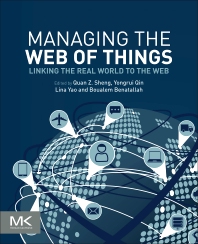LIMITED OFFER
Save 50% on book bundles
Immediately download your ebook while waiting for your print delivery. No promo code is needed.
Managing the Web of Things: Linking the Real World to the Web presents a consolidated and holistic coverage of engineering, management, and analytics of the Internet of Things. T… Read more

LIMITED OFFER
Immediately download your ebook while waiting for your print delivery. No promo code is needed.
Managing the Web of Things: Linking the Real World to the Web presents a consolidated and holistic coverage of engineering, management, and analytics of the Internet of Things. The web has gone through many transformations, from traditional linking and sharing of computers and documents (i.e., Web of Data), to the current connection of people (i.e., Web of People), and to the emerging connection of billions of physical objects (i.e., Web of Things).
With increasing numbers of electronic devices and systems providing different services to people, Web of Things applications present numerous challenges to research institutions, companies, governments, international organizations, and others. This book compiles the newest developments and advances in the area of the Web of Things, ranging from modeling, searching, and data analytics, to software building, applications, and social impact.
Its coverage will enable effective exploration, understanding, assessment, comparison, and the selection of WoT models, languages, techniques, platforms, and tools. Readers will gain an up-to-date understanding of the Web of Things systems that accelerates their research.
Researchers, postgraduate students, communications and network engineers, solution architects, system integrators, system managers interested in the areas of the Web of Things and related computational technologies
Part 1: Modeling and Searching
Chapter 1: Ontologies and context modeling for the Web of Things
Chapter 2: The Anatomy of An Intent Based Search and Crawler Engine for the Web of Things
Chapter 3: Modeling RESTful Web of Things Services
Chapter 4: A Semantic-Rich Approach to IoT Using the Generalized World Entities Paradigm
Part 2: System Building and Practices
Chapter 5: Building a Web of Things with Avatars
Chapter 6: A WoT Testbed for Research and Course Projects
Chapter 7: Using Reference Architectures for Design and Evaluation of Web of Things Systems
Chapter 8: Efficient and Secure Pull Requests for Emergency Cases Using a Mobile Access Framework
Part 3: Data Integration and Analytics
Chapter 9: Automatic Integration and Querying of Semantic Rich Heterogeneous Data
Chapter 10: Building Entity Graphs for the Web of Things Management
Chapter 11: Building Interoperable and Cross-Domain Semantic Web of Things Applications
Chapter 12: Web of Things Data Storage
Part 4: Applications, Security and Social Impact
Chapter 13: WoX: Model-Driven Development of Web of Things Applications
Chapter 14: Security Issues of the Web of Things
Chapter 15: A Web of Fitness “Things”: An Exploration of Social Impacts & Vulnerable Populations
MS
YQ
LY
BB